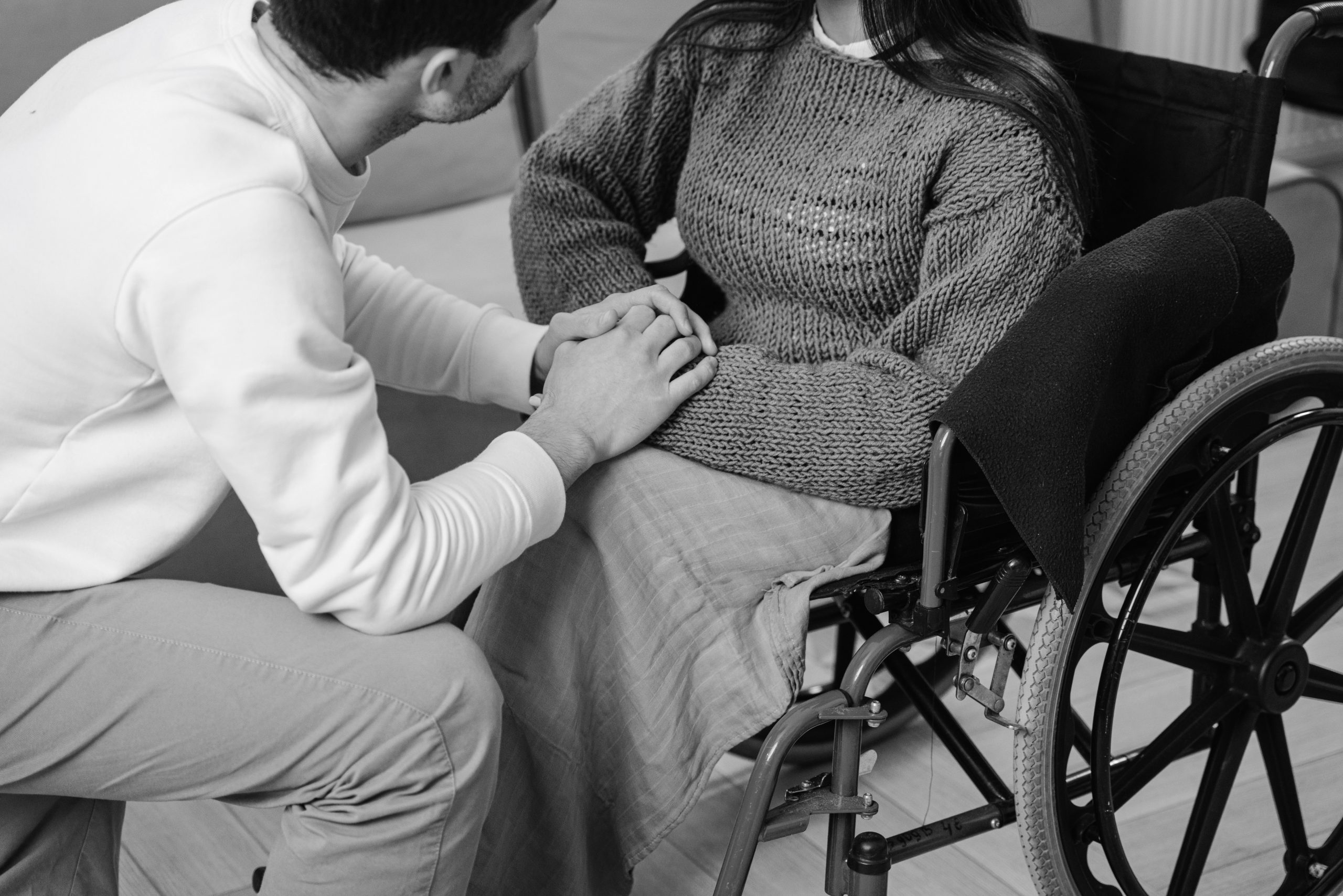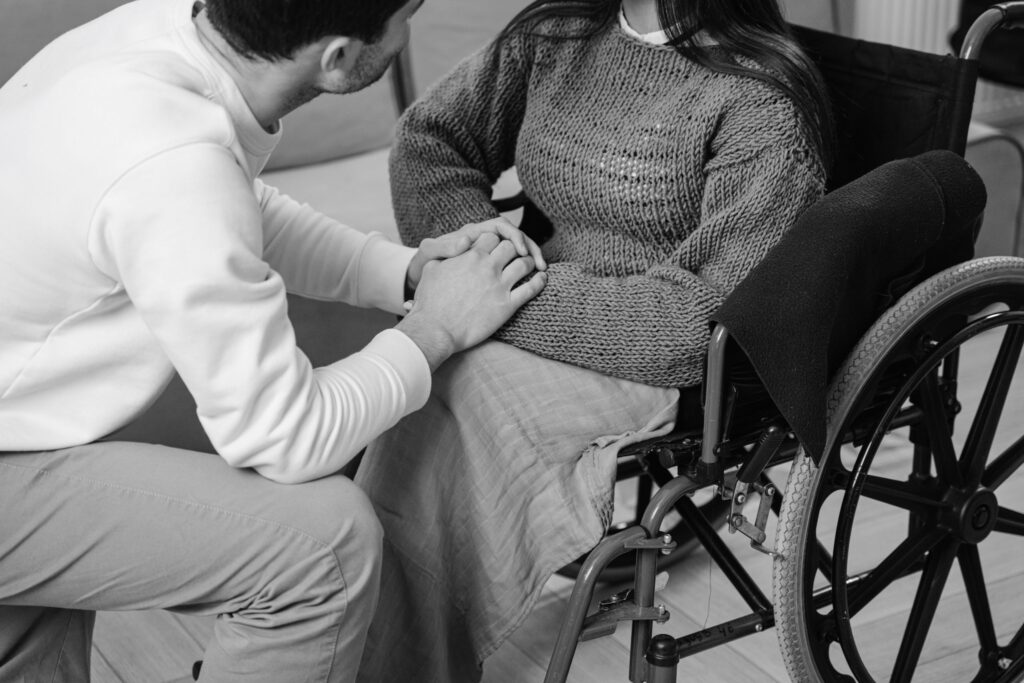
12 Aug Barriers Persist in California for Patients with Disabilities Who Seek an Assisted Death
by Melanie Marcus

Lonny Shavelson, MD, has prescribed Medical Aid-in-Dying (MAiD) over 200 times in the state of California. In late summer 2021, Shavelson, along with two individuals with degenerative neuromuscular diseases who qualify for MAiD in the state of California filed an injunction against California Department of Health Services, requesting judicial review for what they considered a reasonable accommodation under Title II of the Americans with Disabilities Act (ADA) (ADA.gov; ADA as amended 1990): physician administration of the medication for when the patient is unable to self-administer. The California End of Life Options Act requires that patients have a prognosis of six months of life, suffering from “incurable and irreversible” disease, and the “physical and mental capacity to self-administer” (Dinezo). The plaintiffs argued that under the Americans with Disabilities Act, those who are not capable of self-administration, but meet all other qualifications should have the accommodation of physician-administration of their medication. Otherwise the lack of access to the option would constitute discrimination (Dinezo).
Sandra Morris, co-plaintiff with Dr. Shavelson, is a middle-aged woman diagnosed with ALS, an incurable and degenerative neuromuscular disease which will eventually claim all muscular control in her body. Since diagnosis in 2018, she joined twitter and has become a “bulldog warrior” for those suffering from ALS, advocating for funding and research as well as more accessible and ethical clinical trials for those with ALS. Sandra seeks to use California’s End of Life Option Act (2015), which was modeled after Oregon’s 1997 Death With Dignity Act and requires that the patient self-administer life-ending medications. Given Morris’ condition, she will eventually be unable to do so. The California End of Life Options Act encourages her, and those suffering from similar neuromuscular degenerative diseases, to make use of MAiD before her desired end, else lose the right to make that choice (Deprez, 2021). Her twitter profile (@sandymorris333) features family pictures and personal stories alongside ALS advocacy. From retweeting lemonade stands raising funds for research to calls for direct action from legislators, she amplifies the voices of those sharing the cause. The bio reads: “Incredibly blessed wife, mother, ALS warrior, and necessary troublemaker.” Morris’ case, and her plea, provide the opportunity for important reflection on the relationships between disability, dignity, care, and the law.
As of June 22, Morris is currently capable of self-administration but faces imminent risk of losing the ability to self-administer (Dinezo). Shavelson and Morris believe that the prohibition of assistance for those who otherwise meet all criteria for medical aid-in-dying but lack the ability to self-administer consititutes discrimination against those with disabilities and violates the equal-access provisions of the Americans with Disabilities Act. This discrimination is made clear, according to Morris, by the way the Act forces those who are facing degenerative illness to act earlier than they would if assistance was available, shortening their own lives to avoid powerlessness and undue suffering (Deprez).
In a court filing, Morris shared: “It feels so cruel to me that because of the way the EOLOA is written, that I will have to tell my children that I have to leave them earlier while I still have the use of my hands, and while I can still swallow the medication — rather than having the assistance I need with ingestion so I can stay with them a few extra weeks, or days, or hours. [ …] I should not be asked to die early just because I’m severely physically disabled” (Dinezo).
Morris knows that the self-administration barrier leaves her with three choices each day: 1) to seek aid-in-dying medication while she is still able to swallow but forfeit days if not months with her family and her ALS advocacy; 2) to defer the decision to take aid-in-dying medication into the near future with the hope that she still qualifies; 3) or, take her time with her family until her death may be the drawn out death-by-suffocation, which is unfortunately suffered by many ALS patients as one’s body loses critical function (Deprez).
If Morris were in another jurisdiction, outside the United States, these concerns about disability access would not be so poorly addressed. In Canada, where medical assistance in dying has been ruled a right under the Canadian Charter of Rights and Freedoms, both self-administered and physician-administered prescriptions are permitted, with separate safeguards and procedures for each. This has been in practice since the June 2016 federal legislation which authorized MAiD following the Supreme Court decision Carter v Canada (2015) striking down the criminal prohibition of MAiD (Steger). In both the Netherlands and Belgium, physician administered aid-in-dying, also described as direct euthanasia, has been legal since 2002 (Deprez). Thus, barriers to access that persist for the physically disabled within the current legal framework of MAiD is a concern unique to the American legal system.
In interviews with Katie Engelhart for her 2021 book, The Inevitable: Dispatches on the Right to Die, Lonny Shavelson encouraged Engelhart to understand his profound sentiments towards the many problems with the California law. Among them, the lack of guidance and standard-setting for medical aid in dying procedures: Shavelson has had to learn over time what compound medications are most effective for the procedure, lacking any official guidance from the law or the state medical board (Engelhart). Shavelson described reaching out to the medical board, legal counsel, and others, expressing the need for guidance for his own medical practice as well as the need for standards of care. He expressed concern for standard setting and interpretation for the medication regimen provided as well as the procedural criteria and limitations, particularly for patients with mobility challenges, as is crucial in Morris’ case (Engelhart).
California’s End of Life Options Act had been the target for multiple lawsuits before Shavelson v Bonata, but challenged its legality rather than suing for greater accessibility. The law was briefly struck down in 2017 pending a suit brought against the state of California by the Life Legal Defense Foundation, representing religiously affiliated health providers from California who oppose the bill (Solis). The court first ruled the case unconstitutional on a procedural basis, found on appeal that the plaintiffs did not have standing to bring the case, as the patients who were allegedly harmed by the bill were not represented among the plaintiffs (Solis)(AP). The court formally ended all proceedings associated with the lawsuit when the legislature renewed the California End of Life Options Act for five more years in 2021. The renewal eliminated the plaintiff’s concern that the law was illegitimately introduced during a special legislative session on healthcare arguing that MAiD does not constitute healthcare, and so eliminated the legal basis of the suit (Thompson). According to reporting by Thompson for the Associated Press, the plaintiffs are not satisfied and will continue to pursue means of eliminating access to medical aid in dying. Thompson wrote that the Vice President of legal affairs for the Life Legal Defense Foundation, Katie Short, indicated they continue to feel that the law “is a deeply unjust and ill-advised law” which was illegally instituted.
Seeing that the court was unlikely to grant the accommodation for wholly physician-administered MAID, the plaintiffs offered an alternative: physician-administered MAID. This accommodation would allow for patients who are too physically weak or disabled to begin the self-dosage, with a physician helping them to ingest the dose of medication (Renda). Without such an intervention, these patients could suffer the painful side effects of an uncompleted dose, including nausea, vomiting, pain, loss of consciousness, and an ultimately incomplete procedure. Dr. Shavelson believes that patients who seek medical aid-in-dying do so with the hope and expectation that their death may be faster and less painful than otherwise (Engelhart). Without physician assistance, patients might otherwise experience severe trauma and disorientation rather than the peaceful death they had wished (Renda).
Despite the above, on June 22, 2022, the court dismissed the case, with particular regret for the suffering of patients. Justice Chhabria determined that their request would fundamentally alter the California End of Life Options Act “from the ability to end your own life to the ability to have someone else end it for you” (Dinezo). During preliminary hearings, the plaintiffs had filed for an informal alteration to the accommodations requested: that when physically disabled patients are able to initiate the medical aid-in-dying process –whether by pushing a plunger, drinking a liquid, or depressing a syringe – but are unable to complete the movement, they can be assisted by their aid-in-dying physician. Justice Chhabria did not accept this change to the suit on a procedural basis. No public comments from Shavelson, Morris, or their counsel have been made at this time.
Works Referenced
ABx2-15 End of Life, 2015-2016, Reg. Sess. (CA. 2016).
Kiskadden-Bechtel, S. (2021). 2nd Annual Fall Conference – Session Three, Thursday, November 11th, 2021. Vimeo. Completed Life Initiative. Retrieved July 1, 2022, from https://vimeo.com/647084155.
Deprez, E. E. (2021, December 17). A Fight to Die. Bloomberg.com. Retrieved July 1, 2022, from https://www.bloomberg.com/news/features/2021-12-17/death-with-dignity-right-to-die-laws-leave-patients-with-impossible-choice
Dinzeo, M. (2022, June 22). Judge: California aid-in-dying law doesn’t discriminate against the disabled. Courthouse News Service. Retrieved July 7, 2022, from https://www.courthousenews.com/judge-california-aid-in-dying-law-doesnt-discriminate-against-the-disabled/
Engelhart, K. (2021, March 2). ‘I’m the doctor who is here to help you die‘. The Atlantic. Retrieved July 1, 2022, from https://webcache.googleusercontent.com/search?q=cache%3AVHWTW-rFW0cJ%3Ahttps%3A%2F%2Fwww.theatlantic.com%2Fhealth%2Farchive%2F2021%2F03%2Faid-dying-lonny-shavelson%2F618139%2F%2B&cd=8&hl=en&ct=clnk&gl=us.
Morris, Sandra [@sandymorris333]. (n.d.). Tweets & replies [Twitter profile]. Twitter. Retrieved July 6, 2020, from https://twitter.com/sandymorris333?lang=en
Renda, M. (2022, April 14). Key aspect of California assisted suicide law parsed in Federal Court. Courthouse News Service. Retrieved July 5, 2022, from https://www.courthousenews.com/assisted-suicide-law-in-front-of-federal-courts/.
Solis, N. (2018, June 15). California right-to-die law reinstated. Courthouse News Service. Retrieved July 7, 2022, from https://www.courthousenews.com/california-state-appeals-court-reinstates-right-to-die-law/
Steger, M. (2021, September 7). Update on medical assistance in dying in Canada. British Columbia Law Institute. Retrieved July 7, 2022, from https://www.bcli.org/update-on-medical-assistance-in-dying-in-canada/.
Thompson, D. (2021, November 5). Lawsuit briefly blocking California Assisted Death Law Ends. AP NEWS. Retrieved July 1, 2022, from https://apnews.com/article/business-health-lawsuits-california-riverside-1e2de6e518d2b3bd6001d20d1d0be5e7.


